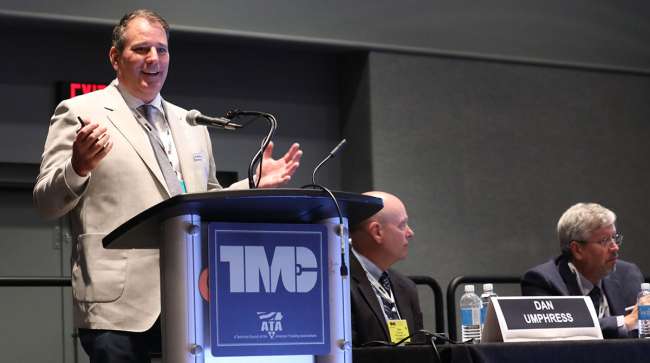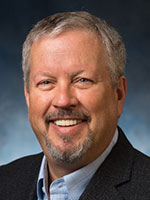Features Editor
Industry Experts Tell Fleet Managers to Be Proactive With Electrification

[Stay on top of transportation news: Get TTNews in your inbox.]
ORLANDO, Fla. — When implementing a charging station for a commercial fleet, managers should heed the simple phrase, “plan early.” That was the recurring theme in the Electric Vehicle track panel session, Recommendations for Developing Charging Station Infrastructure for Commercial Fleet Operations.
The presentation, made at the Technology & Maintenance Council 2022 Annual Meeting & Transportation Technology Exhibition on March 8, provided suggestions for fleet managers when considering implementing fleets, especially when installing charging stations.
Alireza Khani of the University of Minnesota explained the advantages of electric fleet vehicles compared with diesel.

Khani
“Electric cars are going to be more agile. They regenerate electricity, cause less traffic congestion, and they may be able to take a direct route through urban areas,” he said. “Therefore, I think that by investing, there is potential for operating in no-emission zones in urban areas where diesel trucks are not allowed to operate.
“There’s a potential for operating in quiet times at late night or early morning at the time that diesel trucks may not be able to operate because electric trucks are going to have less noise.”
Khani had gathered research data from fleet routes across the state. He noted that Minnesota was an ideal proving ground since 13% of the state’s total pollutants are caused by trucks.
Sean Larkin, national sales director for medium/heavy-duty vehicles for Amply Power, advised fleets to “start the conversations early” when planning to install charging stations. He emphasized the market is continuing to grow at a fast pace, thus the demands for infrastructure and e-fueling need to focus on reliability and intelligence.

Learn about real-world adoption strategies for self-driving trucks with Robert Brown of Spartan Radar and Charlie Jatt of Waymo. Hear a snippet above, and get the full program by going to RoadSigns.TTNews.com.
“The first step is understanding knowledge and why. Everybody in this room, you don’t have to be an expert,” he said. “Your role is to make sure that your vehicles and your fleets are operational and mission critical.”
Larkin noted that fleets he has spoken with in the past that have planned for EVs weren’t sufficiently prepared, for instance, purchasing trucks before planning infrastructure. He also said that planning should take several months to a year.
“You have to plan early, communicate with your stakeholders,” he said. “When you’re thinking about developing a road map for trucks, you have to think about infrastructure at the same time.”

Westlake
Peter Westlake of the Orlando Utilities Commission also reiterated early preparation for fleet electrification. He said that the planning is complex, with consideration needed for locations for charging systems, knowing what power a fleet needs, what are the vehicle duty cycles and conversion timing.
Westlake said that fleets must reach out to their local utility provider to learn the ins and outs of dealing with electric charging. Also, he called for fleets to change their mindset when preparing for electrification.
“You have to rethink your operations,” he said. “If you think that you’re going to take a gas vehicle and all the things that you do with a gas vehicle and just change the fuel type over to electric, think again.”
Want more news? Listen to today's daily briefing below or go here for more info:


&uuid=(email))
